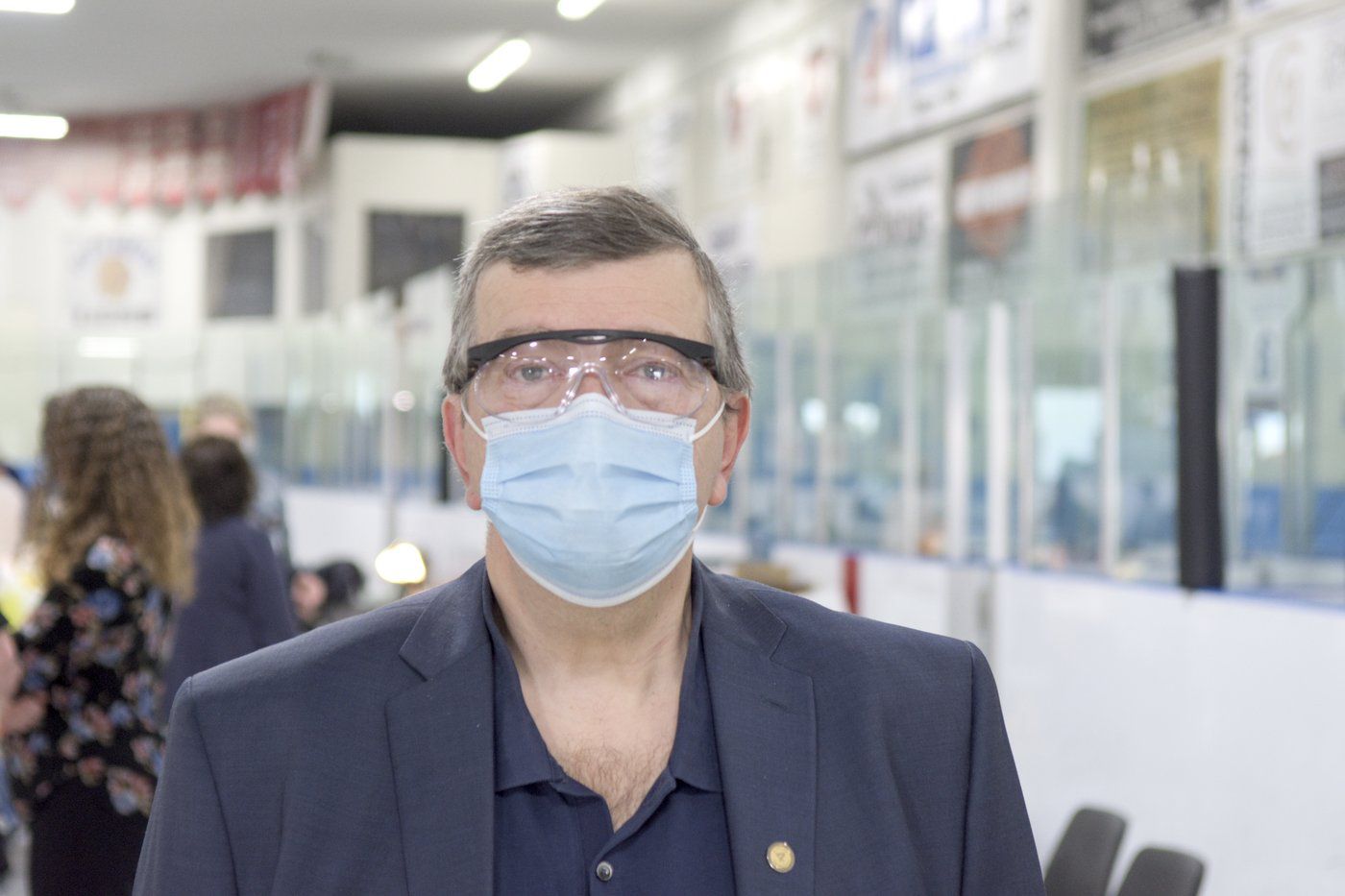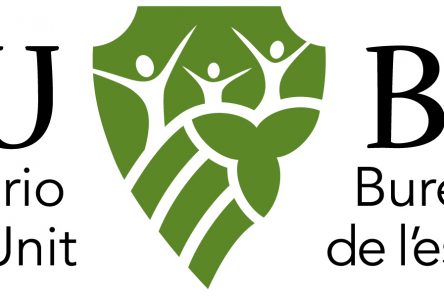SOUTH DUNDAS, Ontario – Eastern Ontario Health Unit Medical Officer of Health Dr. Paul Roumeliotis has been leading local efforts against the COVID-19 pandemic since it began 14 months ago. In an interview with The Leader at the one-day COVID-19 vaccination clinic held in Morrisburg on May 10th, he discussed the continuing vaccination efforts, the current lock-down measures, and some of the longer-term effects of the pandemic.
It has been over a month since the first pharmacies in the EOHU region began delivering vaccines into people’s arms. Still there are only six pharmacies offering vaccinations in the region, compared to over 30 in other rural health units in Ontario.
Roumeliotis said he was still frustrated with the roll out, but a meeting with the provincial vaccine task force last weekend revealed that some changes are in the works.
“We’re out of AstraZeneca,” he said of the provincial supply of the COVID-19 vaccine. “There is going to be some Moderna and Pfizer vaccines redistributed across Ontario, and we will get some of that in our area.”
He clarified that it is more likely that Moderna is the preferred vaccine for pharmacy distribution in this area as it does not require ultra-cold storage.
As there are more shipments of the Pfizer-BioNTech vaccine now arriving in Canada, there is more availability for doses through public health units. Still, Roumeliotis explained that when it comes to a health unit appointment or a pharmacy appointment, there is no preference.
“Whatever is easier, whatever is more convenient,” he said.
Ultimately, the doctor said he sees a long-term strategy of vaccinations and potential booster shots that may be required coming from a variety of providers: the family doctor; the health unit; or a pharmacy.
“It would be no different than the flu vaccine,” said Roumeliotis.
On the current Stay-at-Home order, he said it is going to be extended. The current order ends on May 20th. Last weekend, the Toronto Star reported that an extension of the order was imminent, Roumeliotis confirmed that it was recommended.
As chair of the Council of Ontario Medical Officers of Health, he said that the group had recommended this on May 6th to Chief Medical Officer of Health Dr. David Williams. No official announcement was made by the provincial government before publication deadline.
As for recreation restrictions on sports like golf and related activities, Roumeliotis said he sees a “likely” easing of those restrictions during the extension.
“Likely outdoor amenities, just in the interim, and then a gradual easing of more activity restrictions after the [Stay-at-Home] order expires,” he said.
Slow will be the keyword of any reopening Roumeliotis explained.
“We want a go-slow approach to reopening because we want this to be the last lock-down, period.”
Before the latest shutdown, Ontario used a colour-coded system for managing public health restrictions. In reopening, Roumeliotis said that he would like to see another system instead, one that looked at more public health data to determine what restrictions should be in place.
“It would be based on case numbers, admissions to the ICU, capacity of hospitals and public health units, reproductive rate, and importantly percentage of vaccination,” he said. “To me, we can’t start really reopening until we have a significant amount of the population fully vaccinated.”
For Roumeliotis, that amount is at least 60 per cent of the population in the EOHU region, or about 120,000 people. The health unit has administered over 75,000 individual doses of vaccine, mostly Pfizer, which requires two doses for a person to be considered vaccinated.
Elementary and secondary students in the province have been remote-learning for nearly a month now, and there has been no announcement from the Ministry of Education on how long that will continue. Roumeliotis said that reopening schools is still being considered, but acknowledged that the end of the school year is fast approaching.
“We decided we are looking at it separately than the rest of the lock-down.”
Reopening schools before the end of June to in-person learning requires having local ability to respond to outbreaks in schools, and local case numbers in the community.
“I’m not ruling out that there might be a regional reopening,” he said.”
Mental health, and overall health outcomes, in children is something that Roumeliotis has focused on at the EOHU since he joined as CEO of the organization 15 years ago.
When asked how far the pandemic has set back children, with the school disruptions and restrictions, he said the set back is variable.
“It depends on the socio-economic status,” Roumeliotis explained. “I am most worried about the more vulnerable groups, single parent families as an example,” he said.
As the pandemic has raged on for nearly 15 months, he said he was unsure how long it would take for the region to catch up on some of the programs and help the health unit provides.
“I think it will take some time for us to recover,” he said. “Kids are resilient, that’s another thing I know as a pediatrician.”
He cautioned that there is the potential for a disproportionate number of children who could be left behind, either from a learning, financial or health care standpoint.
“As we know from going into the schools, there are certain socio-economic groups that are less ready, less prepared. That is going to increase that discrepancy,” he said.
Many of the programs offered by the health unit were suspended as staff and resources were moved to handle testing centres, contact tracing and now vaccination centres. These include programs for prenatal, parenting, and childhood development, along with healthy eating, dental screening and counselling services.
One thing that the pandemic response has proven, in Roumeliotis’ opinion, is the value of a local public health unit.
In late 2019 and early 2020, there were discussions by the provincial government on possibly amalgamating Ontario’s 34 public health units, similar to what was underway with the Local Health Integration Networks.
As health units have been on the front line of the COVID-19 pandemic for testing, contact tracing, and now vaccination, Roumeliotis said that he believes the case has been made to keep the health units the way they are.
“I think we’ve made the case that local public health is very important,” he said. “Knowing the local landscape is very important. You cannot get that from a regional approach.”
He explained further that if a larger health unit system was in place, there wouldn’t have been vaccination clinics like the one in Morrisburg May 10th.
“Look, we’re in a small town (Morrisburg) and it would get drowned out if you have a territory of 20,000 square kilometres,” Roumeliotis said.
The EOHU region covers just over 5,300 square kilometres.
“If I was overseeing a huge swath of population, we wouldn’t be able to have this localized, customized approach.”
Roumeliotis said that saying no to merging health units does not mean that there is no room for improvements to be made.
“The lesson here is that, yes, there are some improvements to be made among public health,” he explained adding that some of the very small public health units may need to be merged, but not the EOHU.
“There is a way of collectively getting together and having uniformed approaches where it counts,” Roumeliotis said. “But we still need to have the local ability to customize and to tweak mandates for the local needs. The farther you are away from that, the more difficult it gets.”
This article was originally written for and published in The Morrisburg Leader.



